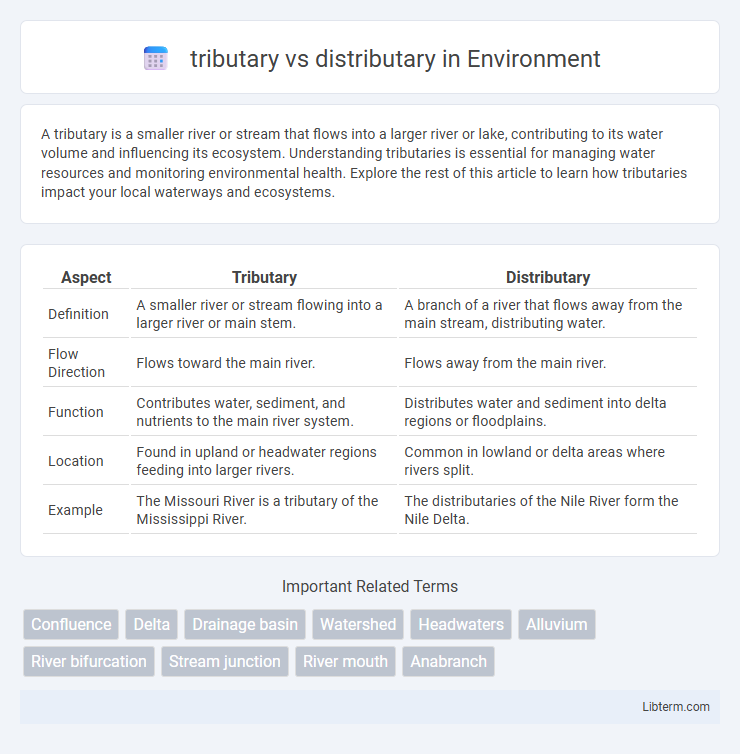A tributary is a smaller river or stream that flows into a larger river or lake, contributing to its water volume and influencing its ecosystem. Understanding tributaries is essential for managing water resources and monitoring environmental health. Explore the rest of this article to learn how tributaries impact your local waterways and ecosystems.
Table of Comparison
| Aspect | Tributary | Distributary |
|---|---|---|
| Definition | A smaller river or stream flowing into a larger river or main stem. | A branch of a river that flows away from the main stream, distributing water. |
| Flow Direction | Flows toward the main river. | Flows away from the main river. |
| Function | Contributes water, sediment, and nutrients to the main river system. | Distributes water and sediment into delta regions or floodplains. |
| Location | Found in upland or headwater regions feeding into larger rivers. | Common in lowland or delta areas where rivers split. |
| Example | The Missouri River is a tributary of the Mississippi River. | The distributaries of the Nile River form the Nile Delta. |
Introduction to Tributaries and Distributaries
Tributaries are smaller streams or rivers that flow into a larger river, contributing additional water volume and sediment load. Distributaries, in contrast, branch off from a main river and flow away, often found in deltas where they distribute water and sediment into another body like a lake, sea, or ocean. Understanding the dynamics of tributaries and distributaries is essential for managing watershed hydrology and sediment deposition patterns.
Definition of a Tributary
A tributary is a smaller river or stream that flows into a larger river or main stem, contributing water, sediment, and nutrients to the primary watercourse. It plays a crucial role in expanding the drainage basin of the main river and influencing the hydrology and ecology of the watershed. Unlike a distributary, which branches off and flows away from the main river, a tributary converges into the main channel, increasing its volume and flow.
Definition of a Distributary
A distributary is a branch of a river that flows away from the main stream and directs water towards multiple outlets, often forming deltas or marshlands. Unlike tributaries, which feed water into a larger river system, distributaries distribute water away from the main river, helping to spread sediments across floodplains. These channels play a crucial role in shaping river deltas and maintaining ecological balance in coastal environments.
Key Differences Between Tributaries and Distributaries
Tributaries are streams or rivers that flow into a larger river or lake, increasing its water volume, while distributaries branch out from the main river, distributing water into multiple smaller channels typically found in river deltas. Tributaries contribute to the drainage basin and gather water from various sources, whereas distributaries help in sediment deposition and reduce flow velocity as the river approaches its mouth. The primary difference lies in their direction of flow relative to the main river: tributaries flow toward it, and distributaries flow away from it.
Formation and Development Processes
Tributaries form through the convergence of smaller streams or rivers flowing into a main river channel, typically developing in upland areas due to runoff accumulation and erosion over time. Distributaries develop as a river approaches a delta or floodplain, where sediment deposition causes the main channel to split into multiple smaller branches that distribute water away from the main flow. Both processes are influenced by factors such as topography, sediment load, and hydrological conditions, shaping the drainage network and river dynamics.
Roles in River Systems
Tributaries contribute additional water, sediment, and nutrients to the main river, increasing its flow and supporting diverse aquatic habitats along its course. Distributaries branch off from the main river, distributing water and sediments into deltas or floodplains, facilitating nutrient-rich soil deposition essential for agriculture and ecosystem productivity. Both play crucial roles in shaping river hydrology and maintaining ecological balance within watershed systems.
Examples of Major Tributaries Around the World
Major tributaries such as the Missouri River feeding into the Mississippi River, the Ganges joining the Brahmaputra in India, and the Yangtze's tributary, the Jialing River in China, demonstrate how tributaries play a crucial role in enhancing the volume and flow of a primary river. The Amazon River, known for its extensive network, includes significant tributaries like the Madeira and Rio Negro rivers that contribute substantially to its discharge and biodiversity. These tributary systems are vital for managing regional water resources, supporting ecosystems, and sustaining human populations worldwide.
Examples of Notable Distributaries Globally
The Nile River's Rosetta and Damietta branches in Egypt are classic examples of distributaries, splitting off from the main river to flow into the Mediterranean Sea. In India, the Ganges-Brahmaputra Delta features the Hooghly River as a prominent distributary that diverts water from the Ganges River. The Mississippi River Delta in the United States includes several distributaries, such as the Atchafalaya River, channeling water away from the main river into the Gulf of Mexico.
Environmental Impact and Significance
Tributaries contribute to the environmental health of river systems by supplying fresh water, nutrients, and sediment, supporting biodiversity and maintaining aquatic habitats. Distributaries, commonly found in river deltas, facilitate sediment deposition that creates fertile land and rich ecosystems but can also alter salinity and disrupt existing habitats downstream. Understanding the balance between tributary inflow and distributary outflow is crucial for managing water resources, mitigating pollution, and preserving ecological integrity in watershed areas.
Conclusion: Importance in Hydrological Networks
Tributaries and distributaries play crucial roles in hydrological networks by facilitating water flow and sediment transport. Tributaries increase river discharge and contribute to watershed connectivity, while distributaries distribute water across deltas and floodplains, supporting diverse ecosystems. Understanding their functions is essential for effective water resource management and flood risk mitigation.
tributary Infographic

 libterm.com
libterm.com